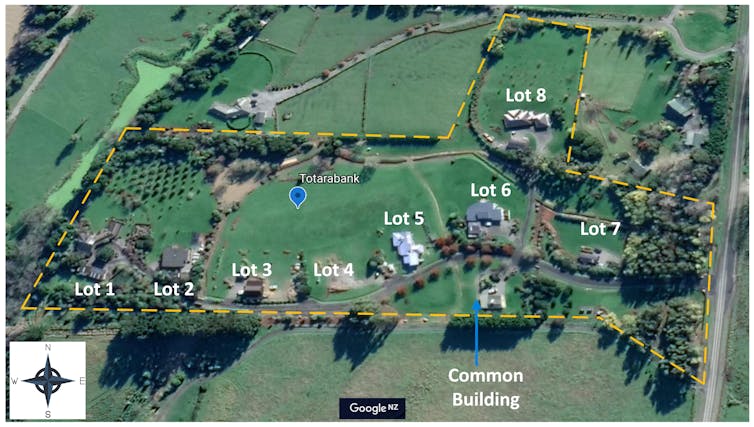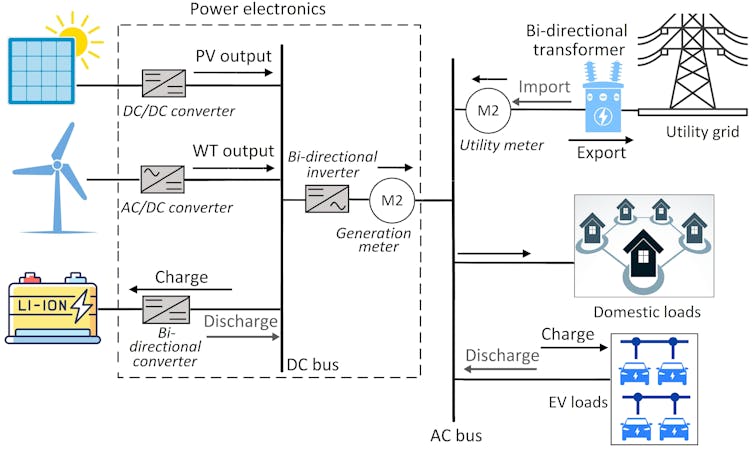By Soheil Mohseni & Alan Brent*
Globally, the electricity sector is shifting from large, centralised grids powered by fossil fuels to smaller and smarter renewable local networks.
One area of strong interest is “energy arbitrage”, which allows users to buy and store electricity when it is cheaper and sell or use it when the cost is high.
But Aotearoa New Zealand is slow to take this up – even though it is a crucial part of the transition to a zero-carbon future. Why is this?
Small-grid technologies and infrastructure are still in the experimental phase, being tested for effectiveness and desirability of different set-ups, ownership models and commercial arrangements. And intelligent energy-management systems that can provide a prescient forecast of market dynamics are not used widely.
To better understand these dynamics, we’ve modelled a theoretical “microgrid” in a residential subdivision, Totarabank, in the North Island of Aotearoa.

We used the model to forecast the expected commercial returns from investing in microgrids and to unlock potential revenue streams from energy arbitrage.
Smart scheduling of batteries
Energy arbitrage requires battery storage and intelligent control to make the most of a local renewable energy system’s generation.
This can be achieved by forecasting short-term future electricity consumption and linking this to the spot power price on the market. Sophisticated real-time controllers then decide if the local system should store or sell to the market (or store and sell later).
Battery storage systems can vary in size, from community-scale batteries supplying a neighbourhood to batteries within a fleet of electric vehicles (EVs). The fundamental controlling processes required to achieve an optimal outcome are broadly the same, except that community batteries are stationary while EV batteries move around.
Community batteries can store electricity purchased from the grid during off-peak periods and then discharge it during peak periods. Neighbourhoods with solar power can charge community batteries in the middle of the day when solar-generated electricity is abundant and discharge during the higher-priced evening peak.
EV batteries can be used similarly, using cheaper night rates or periods of surplus wind during the night to charge. The energy stored in EV batteries can then be discharged into local loads or sold back into the grid when the price is highest, creating an additional revenue stream.
Modelling return on investment
In our modelling, we assumed the primary reasons people will invest in clean-energy technologies are sustainability, energy independence and resilience. We believe energy arbitrage could be an enabler of capital-intensive microgrids, as opposed to an investment made on a purely commercial basis.
Specifically, we considered a grid-connected microgrid integrating solar photovoltaic (PV) and wind turbines. The system is also backed by a community battery and has a fleet of ten personal EVs to serve.

We considered two scenarios: one with grid arbitrage revenues and one without.
Our results suggest revenues procured explicitly from energy arbitrage could reduce the total cost of the system by at least 12%. To put this into perspective, for a typical NZ$10 million town-wide microgrid investment, this means $1.2 million in savings.
Another interesting finding was that the length of time the batteries were able to sustain critical loads during unplanned grid outages was greater by about 16 hours per year, compared to the case without intelligent control. This is a remarkable resilience advantage.
So what does this kind of analysis mean for you? If you are part of a community interested in owning and operating a microgrid, you now have enough evidence to ask your developer to consider energy arbitrage so the community can participate in the electricity market to make a profit.
If you own an EV and are trying to get cheaper night rates, this is a heads-up on future offerings from electricity retailers to get your storage-on-wheels to work with the vehicle-to-grid technology.
On the whole, energy arbitrage is an excellent tool to provide support for renewable energy investment decisions and help firm up revenue forecasts.![]()
*Soheil Mohseni, Postdoctoral Research Fellow in Sustainable Energy Systems, Te Herenga Waka — Victoria University of Wellington and Alan Brent, Professor and Chair in Sustainable Energy Systems, Te Herenga Waka — Victoria University of Wellington
This article is republished from The Conversation under a Creative Commons license. Read the original article.
14 Comments
what they don't mention is that the cheapest option is not to install batteries at all and use the grid.
Quite right. If you are already paying for a grid connection then it's cheaper to pull power from the grid than to pull it out of your battery that you have charged for free with solar.
I live off grid and when I last did the calculation it was about 40c per kwh in wear on both lead and lithium batteries.
Interesting stat, thanks. We're considering putting in solar on our rural property that is currently on-grid. We can get a loan from the regional council for up to $20K and we're considering putting all that into a grid-tied system with no battery storage, but allowing for a battery if/when they become more viable. Being in Hawkes Bay we can generate a whole lot of power through most of the year (he said, ignoring the huge amount of rainy days lately).
I'm very foggy this morning after a long night but I just realised we have a leaking positive head bore sitting in the paddock that I'm just venting into a pipe to water some trees. I wonder if we could tap that for micro-hydro as well.
When I priced it up for us, we needed a huge peak time load and minimal day load to make it worth investing in a battery so no point.
Hydro only become feasible with very high height difference or cumec scale water movement. I know a scheme run by our local council in their freshwater dam that only makes a small profit because the equipment needs so much maintenance and the height difference and flows are so low.
The bore water can be used to grow energy storage in perennial trees using leaves as solar panels. Much better use of excess water
At some point we are going to have to start looking past chemical storage of electricity (batteries, fossil fuels, hydrogen, etc) and start looking into forms of physical storage. Pumped hydro is the obvious one, but I'd love to see more effort put into flywheels. They have some major advantages over batteries, including much longer service lives and zero reliance on things like lithium and rare earth metals.
Check out the weight systems , i think on the BBC website. Pull a weight up during high production , drop it when power required .
Not sure what the problem is with flywheels , i think it has been off centre interia , because most have been tried for mobile applications.
I wonder about the demand side savings that should be considered before building additional microgrid infrastructure.
Take heating water for example - a family member in an apartment in China has no hot water cylinder and instead presses a button 15 minutes before showering to electrically heat a small reservoir. Hot water on delayed demand, and no maintenance load.
Over here the hot water cylinder uses the lion's share of the power. It heats up every 5 to 6 hours to maintain temperature and acts like a leaky heat battery in between.
If households can put in controls and alter habits to match their intermittent but high loads (solar and heat pump hwc, EV, cooking) with low price times of the day, that often gives a better outcome than extra storage infrastructure.
Oh and stop making houses and heat batteries like sieves
Unfortunately , i think the bigger companies manipulation of the spot price would mean such a scheme would face high risks.
the best option would need a decent size pumped hydro storage to work , if this could be incorporated with a small river or stream that can provide additional power , then it would work well.
No mention of hot water cylinders , a very good storage device , already controlled by ripple , but would work a lot better with more sopisticated controls.
Unfortunately , i think the biggest hurdle will be the consumer , in my experience there is always someone in the household that us going to use a lot of power regardless of the cost or controls in place.
But this is well worth investigating further.
The theory sounds lovely.
I wonder if the reality would be to legislate it out of existence.
Are thinking about power & water at the moment, in terms of having our own source of both. We think we will still need access to both mains, just in case, but the options are certainly getting better & better. If we were rich it would be a no brainer, but we're not, so it's still a brainer.
The govt could always subsidise solar for small schemes and even down to individual houses. We could always trust our govt of course but not if you are living in Spain and ploughed money into solar. They may have re-instituted the subsidy, I don't know. Perhaps kiwiinspain could assist.
https://wattsupwiththat.com/2010/10/19/spains-solar-deals-on-edge-of-ba…
or in the UK
https://wattsupwiththat.com/2011/11/01/britain-pulls-the-plug-on-solar-…
With hindsight it may not have been such a bad subsidy now that the Russo-Ukraine war is on but govts or most people would not have predicted that 11 odd years ago.
Subsidies are a terrible idea in NZ. Solar is not well suited to our climate. In my view solar is already subsidised as solar homes are not paying their share towards infrastructure they want to use on winter morning/evening peaks.
If we built onslow that would be another matter, then we'd have sufficient storage for the grid to really operate as a 'battery' for solar generators.
We did a related plan when we presented to KiwiBuild. A sustainable community, with minimal power grid connected requirements. Almost completely standalone. A few innovative ideas meant we could reduce power requirements into the site by 80+%. This included effluent / potable water / fire, street lights etc.
Is this publicly available? Particularly cost, installed capacity, number of houses and units etc. The good technical and financial stuff. What many people ignore when evaluating a power supply system like this. Links perhaps?
We welcome your comments below. If you are not already registered, please register to comment
Remember we welcome robust, respectful and insightful debate. We don't welcome abusive or defamatory comments and will de-register those repeatedly making such comments. Our current comment policy is here.